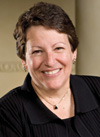 Wisconsin
Lawyer
Wisconsin
Lawyer
Vol. 81, No. 11, November
2008
President's Message
Looking Through the Glass Ceiling
Women have made many advances in the
legal profession, but one big measure of gender equity still looms –
shattering the glass ceiling in large law firms. At the current rate,
women won’t reach partnership parity with men in these firms until 2088.
 by Diane S.
Diel
by Diane S.
Diel
Something happened the other day that was remarkably unremarkable. I
recently participated in a press conference celebrating Juror
Appreciation Month. Featured speakers were Chief Justice Shirley
Abrahamson, then District 1 Chief Judge Kitty Brennan, and Milwaukee Bar
Association President Maria Lazar. No one even seemed to notice the fact
that all the representatives of the courts and the bar associations were
women.
When I graduated from law school in June 1976, no woman had ever
served as State Bar president and no woman was then serving as a judge
at any level anywhere in the state. Later in 1976, in August, Gov.
Patrick Lucey appointed Justice Abrahamson to the supreme court, and by
1978 Gov. Martin Schreiber began appointing women to trial court
judgeships. Today, of course, four of Wisconsin’s seven supreme
court justices are women, and six of 16 court of appeals judges are
women. Law school enrollments are nearly equally divided between men and
women and have been since the early 1990s.
Clearly, after the early years of struggling to figure out how to
comply with circuit court rules that required all attorneys to wear ties
to court, I am now in a time and place in which women are in positions
of power and influence. Case closed, right? Gender equity is now a
given, right?
Well, not really. Trends identified by law school research
demonstrate that women leave the profession in much larger numbers than
men. The glass ceiling is still there for women, given that the
percentage of women partners in large law firms has not changed
significantly over the last 32 years. The statistics reflect that in
2006, only 17 percent of partners in law firms, 20 percent of federal
judges, and 14 percent of Fortune 500 general counsel were women.
According to the Harvard Law School, at the current rate, women
won’t reach partnership parity with men in large firms until 2088.
Root causes for the disproportional attrition of women in large firms
are seen as the culture in such firms, the lack of mentoring
opportunities, and quality of life concerns.
Women bar presidents are much more common now than they were even
10 years ago. However, a recent ABA Bar Leader magazine found
obstacles in the path of would-be women leaders. For example, it is
still extremely rare for one woman to follow another as bar president.
No one thinks a thing about one man succeeding another.
Where do the women leaving the profession go? Some of them do
leave to raise families or for nonlegal careers. The woman chef profiled
in this month’s Bon Appetit is a recovering litigator.
Other women lawyers find success in government, in nonprofits and legal
clinics, and in small law firms. A 2004 study conducted by Harvard Law
School suggests that these forms of employment are consistent with
women’s reasons for entering law school. Twice as many women as
men say that “helping others” was a factor that led to their
application to law school.
In Wisconsin, clearly, small and solo law firms attract many
women lawyers. So many women lawyers in such firms are engaged in family
law practice that, in Milwaukee County, at any rate, it is unusual to
see both parties have men lawyers. In fact, I noticed just such a case
recently in family court. I was struck by how much more remarkable the
presence of two men lawyers was to me in the family dispute than was the
presence of so many women leaders in the juror appreciation press
conference.
What conclusion to take from all of this? First, this is not a
time for women to become complacent and assume that the glass ceiling is
a thing of the past. Also, although women have advanced to positions of
influence and power in the profession, some of the profession’s
institutions have not yet benefited from the strengths women bring. To
remain viable in our changing profession, law firms or other
institutions not yet well populated with women at high levels simply
can’t wait until 2088.
Wisconsin Lawyer
